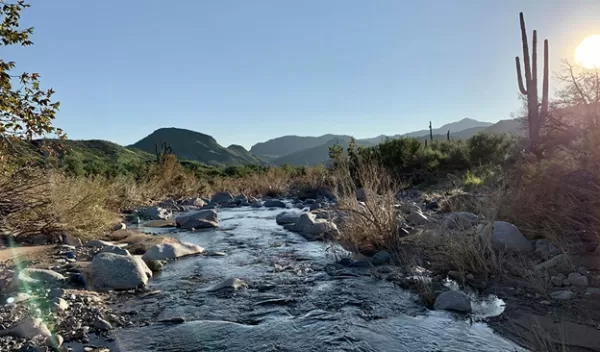
Aquatic organisms respond to flooding and drought in different ways
Populations of various species of aquatic insects and other invertebrates respond to flooding and waterway drying in different ways that can be anticipated, according to a new Penn State-led study that employed a novel method to assess the stability of stream ecosystem communities.
As the frequency and magnitude of floods and droughts increase due to climate change, a comprehensive understanding of the stability of stream ecosystems in response to these disturbances is needed, says lead researcher Daniel Allen.
The dimensional stability framework employed in this research is an innovative approach, Allen believes, in which multiple stability metrics are analyzed, but it has been rarely used in long-term observational studies of natural ecosystems. In this study, researchers applied this framework to a long-term dataset of macroinvertebrates from an intermittent desert stream subject to frequent hydrologic disturbances.
The study found widespread variation in stability over time among invertebrate populations. Scientists also observed that widely varying monsoon disturbances had a greater impact on individual population stability metrics than more consistent winter disturbances.
The research focused on Sycamore Creek in Arizona, in the U.S. National Science Foundation-supported Central Arizona-Phoenix Long-Term Ecological Research site, one of the most extensively studied desert streams in the world. It drains a mountainous watershed of 164 square miles, with a stream gage in the Sonoran Desert. The area has a semi-arid, hot climate. Most precipitation occurs during the winter (December to March) or monsoon (July to September) seasons. Sycamore Creek is prone to flash floods; however, some years the stream's flow is greatly diminished, even drying up.
In findings published in Limnology and Oceanography Letters, the researchers reported on the fate of aquatic invertebrates in Sycamore Creek based on the dimensional stability framework they utilized. Aquatic invertebrate species populations differed in stability metrics.
Some taxonomic groups like Chironomidae (non-biting midges) are very resistant, meaning that the flood and drought doesn't reduce their abundance very much. Other taxa were very resilient, which means that populations get knocked down after a disturbance but regrow rapidly, like Fallceon (blue-winged olives in the family of mayflies called Baetidae) and Oligochaeta (aquatic worms).
“The insights from this work are timely, with conditions in the Western U.S. stressing current management agreements,” says Paco Moore, a program director in NSF’s Division of Environmental Biology.


